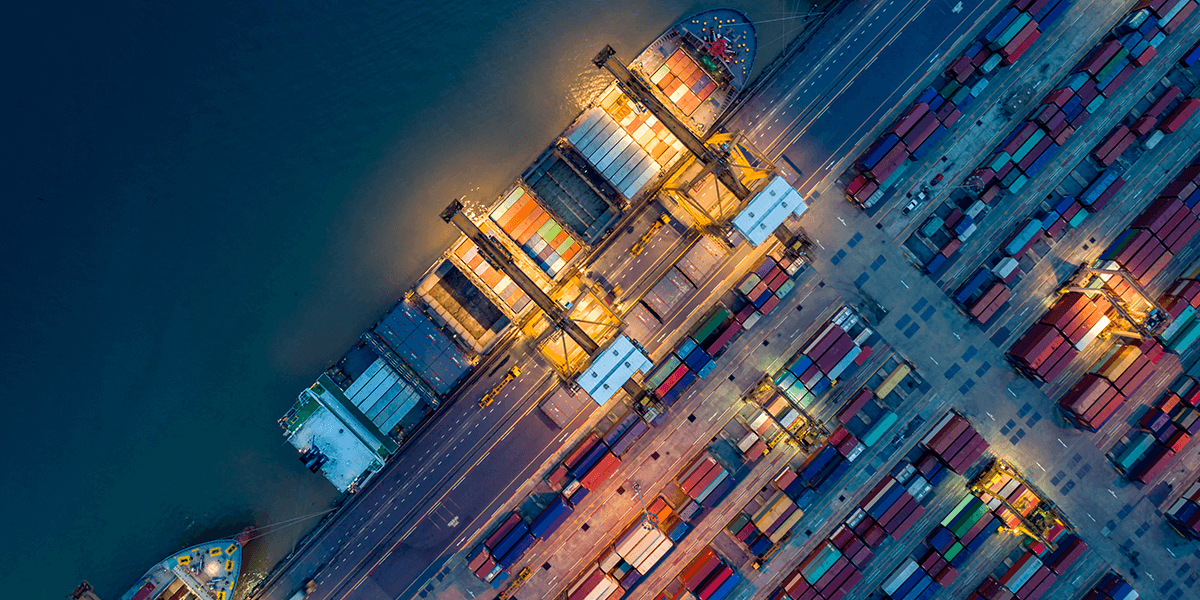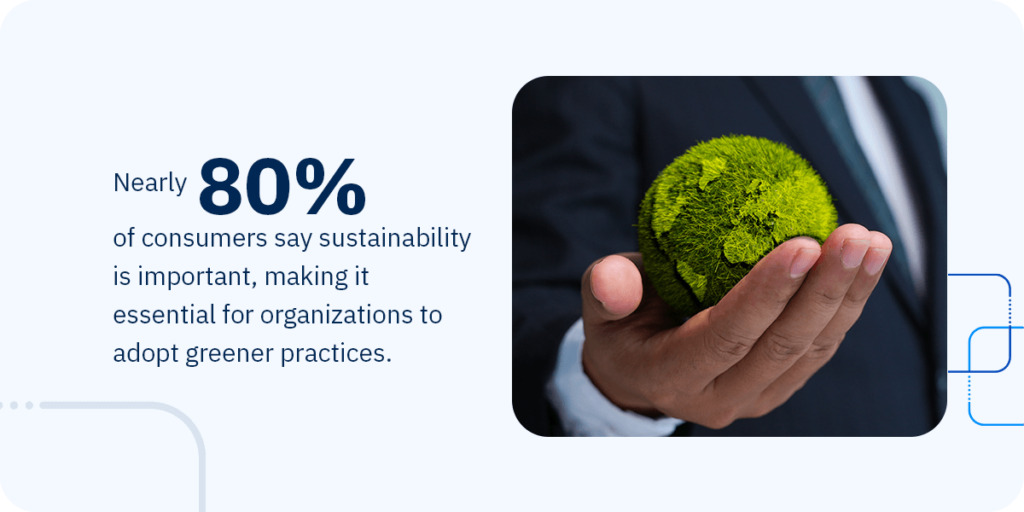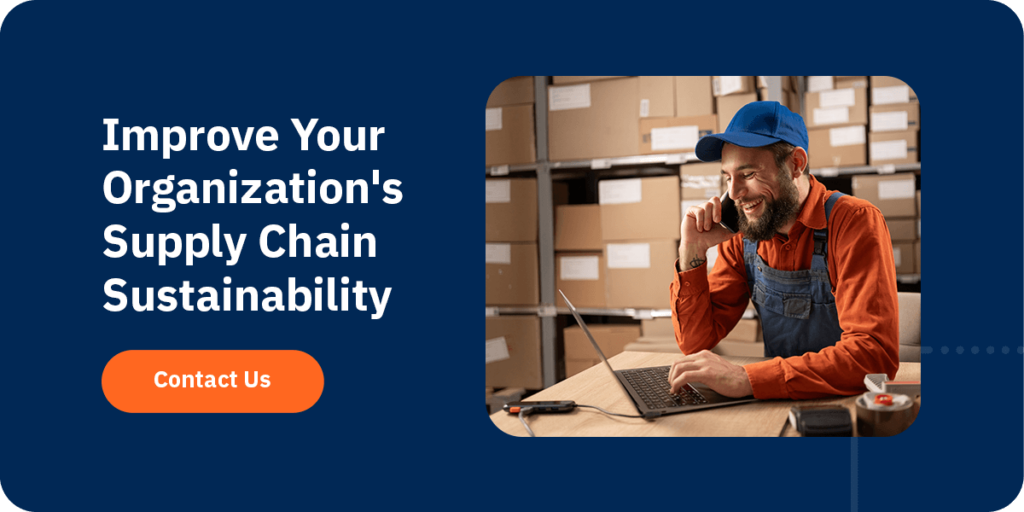Why Is Supply Chain Sustainability Important?

September 4, 2023
Climate change continues to harm the world, resulting in extensive changes in supply chain management. Excessive ground transportation, waste production, and energy use increase carbon dioxide production and supply chain companies’ carbon footprints. Businesses generated over $160 billion in waste in 2022, displaying how management practices have global implications.
By focusing on supply chain sustainability, companies can decrease their carbon footprints and increase brand appeal. Organizations can make comprehensive changes on all supply chain levels to meet sustainability goals.
What Is Supply Chain Sustainability?
Supply chain sustainability is the process of optimizing operations to become more environmentally friendly. Companies can focus on resource optimization, reusable packaging, and other responsible practices to minimize their carbon footprint.
As concerns about climate change grow, many businesses are shifting to more sustainable practices. Producing and transporting goods increase waste production, contributing to greenhouse gas emissions. Supply chain managers benefit their organizations and the environment by switching to more sustainable practices.
Supply chain sustainability focuses on three major elements:
- Environmental responsibility: Sustainable supply chains recognize their environmental impact and work to minimize their carbon footprint however possible. Companies note how production, transport, storage, and other operations can influence the environment and research ways to limit negative effects.
- Social responsibility: Supply chain sustainability also involves the ethics and morals of business operations. Managers address their organization’s effect on society and human life.
- Financial responsibility: Sustainability also evaluates daily operational impacts on an organization’s budget, its financial partners, and other financial institutions.
Importance of Supply Chain Sustainability
Sustainable supply chain practices provide advantages for the environment, efficiency, budgets, and customer attitudes. Here are a few examples of the importance of supply chain sustainability:
- Decreased energy costs: All companies want to reduce costs while maintaining productivity. Many sustainable practices lower energy usage, allowing you to complete production processes in a more environmentally friendly manner. The less energy you use, the more your energy bills decrease. For instance, a sustainable supply chain can set goals to lower its emissions production. Once they reduce emissions, their corresponding energy usage lowers, too.

- Improved customer perspectives: Nearly 80% of consumers say sustainability is important, making it essential for organizations to adopt greener practices. You can inform consumers and shareholders of your sustainable approaches and improve your reputation. A commitment to sustainability can set you apart from competitors and help you remain a leader in your industry.
- Increased compliance: Sustainable practices also help you meet federal and international compliance regulations, such as the United Nations’ Sustainable Development Agenda. Government regulations can require sustainable approaches for waste disposal, production techniques, or other supply chain practices. You can meet these guidelines and avoid penalties by committing to sustainable approaches.
- Enhanced workplace environment: Like consumers, many employees look for industries emphasizing environmental friendliness. You can attract and retain more workers with a sustainable workplace. Employees can feel more fulfilled with their work, which can boost productivity.
Supply Chain Sustainability Best Practices
A sustainable approach requires implementation on all supply chain levels. Supply chains can integrate sustainability in many ways. Here are four essential practices for supply chain sustainability:
1. Evaluate Your Carbon Footprint
An essential first step for sustainability is analyzing your existing methods. Exact environmental impacts vary depending on product type, manufacturing style, and other supply chain practices. You can map out your current practices and identify areas with the most significant waste or carbon production. Then, your organization can adjust approaches to reach more sustainable processes.
You can map every supply chain stage, from acquiring raw materials to distributing final products. Obtain details of typical energy usage, vehicle emissions, waste production numbers, and other essential metrics. By observing an end-to-end view of your supply chain, you can see areas you could have overlooked before. For instance, average vehicle emissions could be more severe than you thought.
This evaluation process gives you a starting point for sustainability implementation. You can start with areas that have the worst environmental impacts and consider ways to decrease them.
2. Switch to More Sustainable Transportation
Supply chain transportation accounts for a significant portion of emissions. Burning gasoline and diesel emits carbon dioxide into the atmosphere, increasing the greenhouse gases on the planet. Using many trucks at once increases your carbon footprint.
Supply chains can use more sustainable transportation practices, such as:
- Partnering with local suppliers: Reducing the physical distance between suppliers and final destinations can decrease your carbon emissions. You can look for suppliers closer to your central location and work with them to develop more streamlined routes.
- Using electric vehicles: Electric vehicles have less environmental impact than traditional combustion engines, making them ideal for supply chain distribution. You could switch your fleet to feature more electric vehicles to reduce your carbon emissions.
- Optimizing shipping space: You can also redesign your shipping approaches to optimize the available space in your shipping trucks. Load as many boxes as possible in a single trip to reduce the number of trips.
3. Minimize Production and Packaging Waste
Production and packaging waste can quickly add up, increasing environmental impact. Companies can take many steps to reduce their waste production. For instance, they can:
- Reuse waste: Other companies could use your waste for packaging or other operations. You can also implement waste into other processes. For instance, instead of disposing of cardboard boxes, you could reuse them for storage.
- Recycle products: Recycling encourages circular product life cycles rather than increasing waste. If you use recyclable materials, such as paper, cardboard, or plastics, your organization should take the proper measures to recycle them.
- Switch to environmentally friendly resources: Your organization can evaluate commonly-used resources and switch to more sustainable options. In particular, plastic lingers in the environment longer than paper and harms ecosystems. Biodegradable materials have less environmental impact and can minimize your carbon footprint.
4. Partner with Sustainable Suppliers
A commitment to supply chain sustainability means change on all operational levels. If you switch to environmentally friendly techniques but still partner with suppliers that use harmful ones, it becomes detrimental to your approach. These partnerships could hurt your brand image or compliance needs.
You can seek partners that prioritize sustainability to create greener initiatives in all stages. Another option is discussing your concerns with existing partners and outlining your expectations for increased sustainability in the future. Transparent communication helps you maintain crucial relationships while focusing on sustainability.

Improve Your Organization’s Supply Chain Sustainability
Supply chain sustainability benefits the environment, companies, and consumers. You can appeal to more consumers and decrease your carbon footprint by switching to more sustainable measures. Strategies such as minimizing waste production, altering transportation routes, and partnering with environmentally focused suppliers can help you meet these goals.
Software solutions such as Electronic Data Interchange (EDI) and Vendor Managed Inventory (VMI) can streamline manual supply chain approaches, giving you more time to focus on sustainability. Technology can help you identify harmful practices and provide the necessary data to enact change.
To learn more about how EDI and VMI can help your organization, contact TrueCommerce today.
Share this post:
Categories
Stay ahead of the competition
Get expert supply chain insights delivered directly to your inbox weekly.